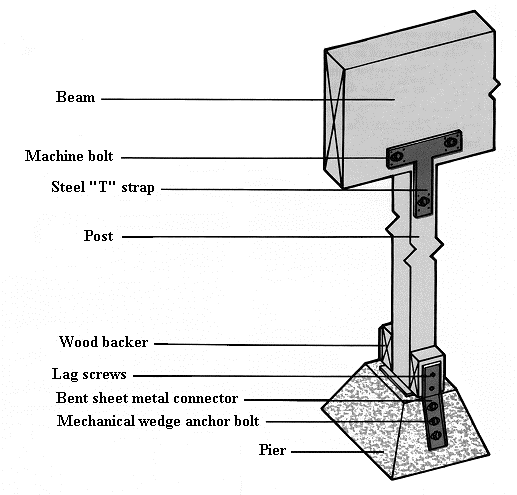
POST AND PIER FOUNDATIONS
The most common problem with post and pier foundations during an earthquake is the tendency of posts to shift off piers and beams to shift off posts. Failure at either of these points can cause the substructure, and sometimes the entire house, to collapse. But steps can be taken to strengthen post and pier foundations. Bolting posts to piers and beams is the most common method. Lateral support can be achieved by installing 2x4s as diagonal bracing from one post to the next.
Pre-drilled steel T-straps are recommended for attaching beams to posts. For attaching posts to piers, pre-drilled, shop-fabricated, heavy gauge, bent sheet metal connectors are recommended (Figure F).

FIGURE F - Reinforcing Post and Pier Foundations
POURED CONCRETE FOUNDATION WALLS
In new construction, poured concrete walls are the most common type of foundation for supporting raised wood floors.
In houses built prior to modern building codes the foundation and sill plate are not always attached, but retrofitting with anchor bolts can substantially improve a homes ability to withstand an earthquake. There are two ways of bolting sills to concrete foundations: vertical and horizontal.
Vertical bolting can be accomplished only if there is enough workspace between the foundation and floor. Horizontal bolting is useful where space between foundation and floor is minimal.
VERTICAL BOLTING: Vertical bolting is the easiest way to attach a house to its foundation. Mechanical wedge anchor bolts are the only hardware needed. Simply drill the holes for the anchor bolts through the sill plate and into the foundation, then install the bolts.
HORIZONTAL BOLTING: Horizontal bolting, a structural steel plate is needed to tie the sill plate to the foundation. The steel plate is attached to the sill plate with lag screws and to the foundation with anchor bolts.